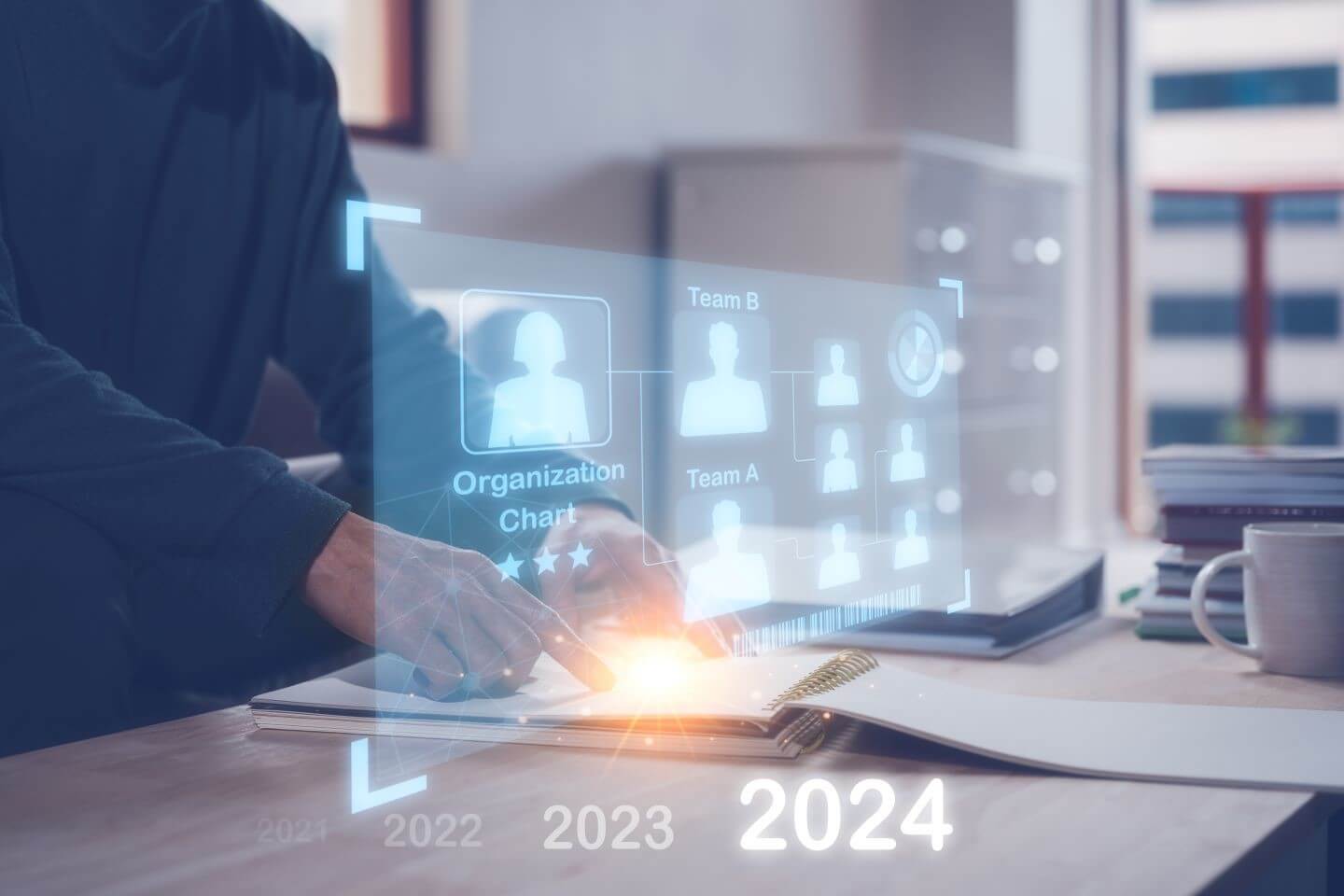Navigating the dynamic field of human resource tech can be overwhelming, but understanding its impact on organizational performance is crucial. With HR technology rapidly advancing, this article cuts through the noise to present the pivotal tech innovations of 2024 — those driving efficiency, fostering employee engagement, and ultimately powering business success. We shed light on practical applications from automated payroll systems to predictive analytics, ensuring you are prepared to harness the full potential of HR tech in your organization.
Key Takeaways
- HR technology in 2024 serves as a strategic tool beyond traditional tasks, emphasizing workforce analytics, automated payroll, talent management, and learning systems, improving employee engagement and productivity.
- AI and machine learning are pivotal in HR processes, from predictive analytics in talent acquisition to unbiased performance evaluations, leading to data-driven hiring decisions and enhancing productivity and decision-making.
- HR tech is crucial for adapting to remote and hybrid work environments, offering tools for virtual collaboration, digital onboarding, data security, and ensuring regulatory compliance within the digital workplace.
1. Decoding HR Technology: The Essentials

HR technology has evolved, transforming into a strategic partner in organizations. It now extends past routine tasks, offers insightful workforce analytics, and secures the best job fit for every individual. The lines between Human Capital Management (HCM), HR Information Systems (HRIS), and HR Management Systems (HRMS) are blurring, with HCM systems becoming more prevalent. These advancements in HR tech are allowing leaders to boost employee productivity, contribute to training and skill-building, and improve retention strategies.
HR technology spans a range of responsibilities, including:
- Payroll and compensation
- Talent management
- Workforce analytics
- Performance management
- Benefits administration
The implementation of HR software can improve productivity by automating processes and reducing manual HR efforts. Strategically selected HR software can automate mundane aspects of HR, thereby freeing up professionals to zero in on strategic tasks and employee advancement.
Let’s further explore three pivotal components of HR technology: Payroll Automation, Talent Management and Acquisition, and Learning Management Systems.
Payroll Automation: Saving Time and Ensuring Accuracy
Payroll management is a crucial aspect of HR that directly impacts employee satisfaction and business success. Advanced HR technology automates the tracking and calculation of wages, sick leave, and vacation time, preventing under or overpayment of employees. This not only streamlines payroll processes but also minimizes errors and ensures data integrity, ultimately contributing to the company’s success.
Consider the following:
- Rectifying a single payroll mistake costs an average of $291.
- HR automation not only conserves valuable resources by minimizing such errors, but it also shields the company from potential legal ramifications.
- Administering wages, salaries, and tax withholding across multiple jurisdictions poses significant challenges, which HR technology payroll providers are adept at handling.
Talent Management and Acquisition: The Competitive Edge
In the fiercely competitive business climate of today, the strategic priority has shifted towards attracting and retaining the cream of the talent crop. Talent management in HR technology addresses this need by covering the entire employee lifecycle, from recruiting to compensation. Modern HR technologies focus not just on immediate skills gaps but also on candidates’ long-term abilities and potential. They achieve this through advanced data integration and strategic role alignment.
Performance management is enhanced with performance management modules within HR systems, offering continuous assessment and AI-driven analysis to help supervisors understand employee performance and progression. Moreover, agile talent management software fosters quick adaptation to changes in talent markets, helping organizations maintain a competitive workforce.
Learning Management Systems: Cultivating Skills and Knowledge
Learning Management Systems (LMS) emerge as an integral part of HR tech, furthering corporate training and skill development. Modern LMS are increasingly incorporating:
- Integrations
- Quick implementation
- Pre-built courses
- Multiple languages
- Social learning features
These features enhance learning and development.
Customization options in open-source LMS like Moodle cater to the diverse needs of a global workforce, supporting multiple languages and time zones. By cultivating skills and knowledge, these systems contribute to employee productivity, satisfaction, and overall workforce competency.
2. Enhancing Employee Experience with HR Tech

In the digital workforce era, the enhancement of employee experience has ascended to a top priority for HR leaders. HR tech trends for 2024 focus on improving the employee experience from end to end and fostering a skilled and empowered workforce. One way HR technology achieves this is by providing employees with instant access to necessary resources, reducing frustration and increasing productivity.
Hyper-personalization has emerged in the workplace, offering flexibility and customizable work environments to better suit individual employee needs. To provide these personalized experiences, organizations are enhancing communication, management, and work environments for employees through HR technology. Let’s examine how self-service portals and performance feedback systems contribute to the betterment of the employee experience.
Self-Service Portals: Empowering Employees
The burgeoning growth of self-service HR portals stands as proof of the empowerment HR technology bestows on employees. These portals allow employees to independently access and manage their HR-related tasks and enhancing employee autonomy and engagement. By improving communication and reducing HR administrative responsibilities, these portals also contribute to efficiency and productivity.
Access to pay stubs and earlier access to their W2s through self-serve portals is a convenient benefit for employees as well a time-saver for HR. Ensuring the format is easy to read on mobile devices helps them access that information from anywhere, even if they don’t own their own desktop computer with Internet access.
Portals with mobile access are also helpful to supervisors who may need to approve timesheets but are not in the office. It is a major convenience and can allow more approved vacations, time off, or conference attendance, especially when timesheet approval is the one task only that person can perform.
Employees can manage their time off and expenses more efficiently through self-service portals, thanks to real-time approvals and easier trackability. The increasing use of mobile applications, chatbots, and customized self-service experiences signals a trend towards more self-service technology.
Performance Feedback Systems: Encouraging Growth
Performance feedback, also known as employee feedback, plays a crucial role in fostering employee growth and employee engagement. Continuous performance management, facilitated by technology, is replacing annual reviews, offering employees real-time feedback and coaching for skill development and career growth. Advanced HR tech tools enable managers to provide timely, personalized feedback to employees, fostering employee growth and engagement.
The integration of performance feedback systems offers several benefits, including:
- Aligning individual goals with organizational objectives
- Allowing for regular communication and growth through a comprehensive view of employee history
- Enabling real-time feedback and career progression through cloud-based tools, AI, and virtual assistants
- Reducing turnover and motivating employees within the company
These systems provide a valuable tool for organizations to enhance employee performance and drive success.
3. The Impact of AI and Machine Learning on HR Processes

The emergence of AI and machine learning has signaled the dawn of a new efficiency era in HR processes. From scanning hundreds of CVs to detect relevant keywords and phrases to answering candidate queries via chatbots and scheduling interviews, AI enhances recruitment processes. AI also contributes to fairness and objectivity in HR by removing bias from performance evaluations and recruitment processes.
Machine learning algorithms enhance productivity and decision-making in HR by providing insights on employee well-being, predicting candidate shortlisting chances, and facilitating data-centric choices beneficial for the company. The influence of artificial intelligence is anticipated to increase across various HR functions as its capabilities continue to advance. Let us probe further into how AI and machine learning are reshaping intelligent recruitment and predictive analytics.
Intelligent Recruitment: Streamlining Talent Acquisition
AI-powered recruitment tools are revolutionizing talent acquisition. Predictive analytics in preselection software assesses a candidate’s suitability for a role, enabling data-driven decisions in hiring. Machine learning technology aids in filtering and tracking applicants with the most relevant qualifications and skills for specific job positions.
Artificial intelligence can detect applicants whose skills and personalities align with those of existing successful team members, suggesting a better fit for given roles. A quarter of companies have already incorporated automation into HR processes to improve the recruitment and onboarding experiences.
Predictive Analytics: Anticipating HR Needs
Machine learning plays a pivotal role in anticipating HR needs. By analyzing large amounts of employee data, it can predict attrition, identify patterns and predictors of turnover, and provide insights for workforce planning. Advanced HR tech tools enable more detailed data analysis and insights that help managers assess individual and team performance and increasingly focus on employee wellbeing.
Tailored learning programs utilize individual performance management and skills data within workforce analytics to enhance employee development. Organizations are embracing a data-driven approach to gain a deeper understanding of their employees and customers, underlining the ongoing trend towards evidence-based HR strategy.
4. Remote Work and HR Tech: Building Connected Teams

As remote and hybrid work models gain more traction, HR tech has stepped up to meet the challenge. In 2024, HR and IT teams are collaborating to tailor technology that adapts to evolving work models, with data and digital technologies playing critical roles in policy and people management. A considerable shift to hybrid work models is expected, with 60% of organizations moving in this direction and facing potential challenges in the process.
Hybrid work model technologies encompass collaborative and communicative tools, task management, and digital information security in a blended workplace environment. Collaboration tools aid in tracking and managing projects for employees regardless of their location, while workplace planning tools offer insights for organizations to create adaptive work environments suitable for the dynamics of hybrid work models. Let’s explore in depth the function of virtual collaboration tools and digital onboarding in the formation of connected teams.
Virtual Collaboration Tools: Keeping Remote Teams United
Virtual collaboration tools such as Slack, Zoom, and Trello play a crucial role in fostering connected remote teams. Real-time messaging, integration hubs, and file-sharing features facilitate communication among team members, irrespective of their geographical location. Video conferencing tools provide essential real-time video interaction, while platforms like Google Hangouts and GoToMeeting integrate well with other corporate tools, enhancing the team’s connectedness.
Project management applications are key to managing remote workflows. Some benefits of using project management applications include:
- Visual boards for task tracking
- Tools to manage project timelines
- Ensuring remote teams stay aligned
- Streamlining the appraisal process for remote employees
- Online platforms that support feedback and collaboration in real-time
- Seamless recording of meetings to verify participation and content
Digital Onboarding: Welcoming New Hires Remotely
Welcoming new hires in a remote work environment can be challenging. However, digital onboarding tools have made this process user-friendly and engaging for employees, irrespective of their geographic location. Some key features of digital onboarding tools include:
- Machine learning, which personalizes the onboarding experience
- Task management, which helps new hires stay organized and on track
- Messaging, which allows for easy communication and collaboration
- File sharing, which enables the sharing of important documents and resources
These features help keep new hires engaged and ensure a smooth onboarding process.
Onboarding software templates accelerate the onboarding process, enabling new employees to promptly focus on core job responsibilities. This ensures a smooth transition and sets the stage for a productive start to their journey with the company.
5. Data Security and Compliance in HR Technologies

In the era of digitalization, the importance of data security and compliance can’t be overstated. HR tech helps protect against data breaches by implementing security measures such as multi-factor authentication, encryption, and role-based access control. Regular security audits and employee training on cybersecurity awareness are key practices in ensuring data security within HR tech systems.
HR technology solutions facilitate compliance with legal and regulatory requirements such as GDPR and EEOC, providing tools for compliance training and reporting. Let’s further investigate how HR tech ensures security of employee records and simplifies compliance.
Secure Employee Records: Protecting Sensitive Information
The security of employee records is a critical aspect of HR tech. Advanced encryption protects sensitive employee data both at rest and in transit, preventing unauthorized access. Two-factor authentication is deployed as an additional security layer to secure access to employee records.
Regular vulnerability scans and penetration testing form part of HR tech’s security strategies, proactively identifying and mitigating potential threats. Governance, risk, and compliance (GRC) policies manage third-party vendor risks, ensuring HR tech remains secure against external threats. Furthermore, self-service portals are equipped with essential security features to protect employees’ sensitive information and comply with regulatory standards.
Regulatory Adherence: Streamlining Compliance
HR tech streamlines compliance by:
- Automating routine tasks
- Freeing up HR professionals to concentrate on strategic initiatives
- Simplifying the creation of reports for regulatory agencies
- Assisting with laws like the Fair Labor Standards Act and the Family and Medical Leave Act
Automated alerts in HR software systems ensure timely compliance by notifying when employees are eligible for programs such as 401(k) plans. Specific management software, like compliance software, is used to effectively manage the administration of leave according to various federal and state regulations.
Summary
In the dawn of HR Tech 2024, we can see how HR technology has significantly evolved to become a strategic partner for organizations. From streamlining HR processes to enhancing the employee experience, from facilitating remote work to ensuring data security and compliance, the innovations in HR tech are truly revolutionary.
The adoption of advanced technologies such as AI and machine learning, the rise of self-service portals, the move towards hyper-personalization, and the focus on data security are reshaping the HR landscape. As we move forward, these trends are set to become more integrated into our workplaces, creating a more efficient, productive, and engaging work environment.
Frequently Asked Questions
What is the best technology for HR Professionals?
The best technology for HR professionals in 2024 includes HR software that incorporates the latest trends in HR technology.
What is the future of HR tech?
The future of HR tech is expected to include artificial intelligence and machine learning, revolutionizing employee experiences and customer satisfaction, and enhancing the entire employee lifecycle. This will lead to organizations remodeling their technical infrastructure to incorporate these advancements, leading to a more efficient and optimized HR technology landscape.
What is the role of a human resources technician?
The role of a human resources technician includes interpreting and applying laws and regulations, maintaining employee handbooks and policies, and attending labor management meetings to take notes. This position plays a crucial role in ensuring compliance and efficiency in the HR department.
What does an HR tech do?
An HR tech’s role involves handling recruitment, verifying credentials, and providing information on employee benefits and compensation.
How is Human Resources technology enhancing the employee experience?
Human resources technology enhances the employee experience by offering instant access to resources, personalizing work environments, and empowering the workforce. This ultimately leads to a better working environment for employees.


